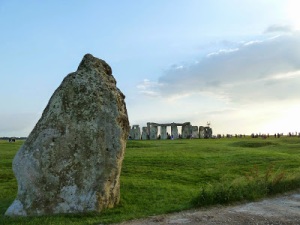Join Time Team favourite Phil Harding and expert guide Pat Shelley for a unique exploration of the Stonehenge landscape at the exclusive Council for British Archaeology (CBA) and English Heritage (EH) members’ event on Sunday 19th April 2015.
The pair will be leading a walk through some of the often-overlooked enigmatic elements of the landscape, combining rich archaeological background with personal anecdotes and replica artefacts. The walk will take around an hour and a half, and highlights will include round barrows at nearby Fargo Woods and the Cursus barrow group, before visiting the Cursus itself. The culmination of the walk will see our group descending into Stonehenge Bottom before walking up the Avenue to Stonehenge.
CBA and EH members will meet at the Stonehenge Visitor Centre where they can enjoy complimentary refreshments  before beginning the walk at 11.30am. Participants should wear suitable clothing and footwear for the walk, and be of a reasonable level of fitness. Please note that this is a walk around the wider Stonehenge landscape putting the monument into its context, and does not include access into the stones themselves.
before beginning the walk at 11.30am. Participants should wear suitable clothing and footwear for the walk, and be of a reasonable level of fitness. Please note that this is a walk around the wider Stonehenge landscape putting the monument into its context, and does not include access into the stones themselves.
Tickets for this CBA and EH members’ event are just £30 per head, and can be booked now via the English Heritage events booking line on: 0370 333 1183. Proceeds from the walk will go towards supporting the work of the Young Archaeologists’ Club (YAC).
Phil Harding is best known and loved as the hat-wearing archaeologist from Channel 4’s Time Team. His expertise lies in prehistory, and his personal experience and anecdotes – coupled with the opportunity to handle some of his beautiful handmade replica artefacts – will add a unique extra dimension to your walking tour.
prehistory, and his personal experience and anecdotes – coupled with the opportunity to handle some of his beautiful handmade replica artefacts – will add a unique extra dimension to your walking tour.
Pat Shelley is an experienced independent guide, with years of experience of bringing Stonehenge and its landscape to life. Described on ‘TripAdvisor’ as “the ONLY way to see Stonehenge”, Pat is an engaging speaker who will be only to pleased to share his love of Stonehenge with you, and answer any questions that you might have.
Visit the Council for British Archaeology Website for full details.
Visit the English Heritage website if you are planning to visit Stonehenge
Stonehenge Guided Tours offer frequent tours and many also include ‘Stonehenge Inner Circle Access Tours‘
The Visit Wiltshire website lists local operators based in Salisbury offering Stonehenge tours
Merlin @ Stonehenge
The Stonehenge News Blog

















